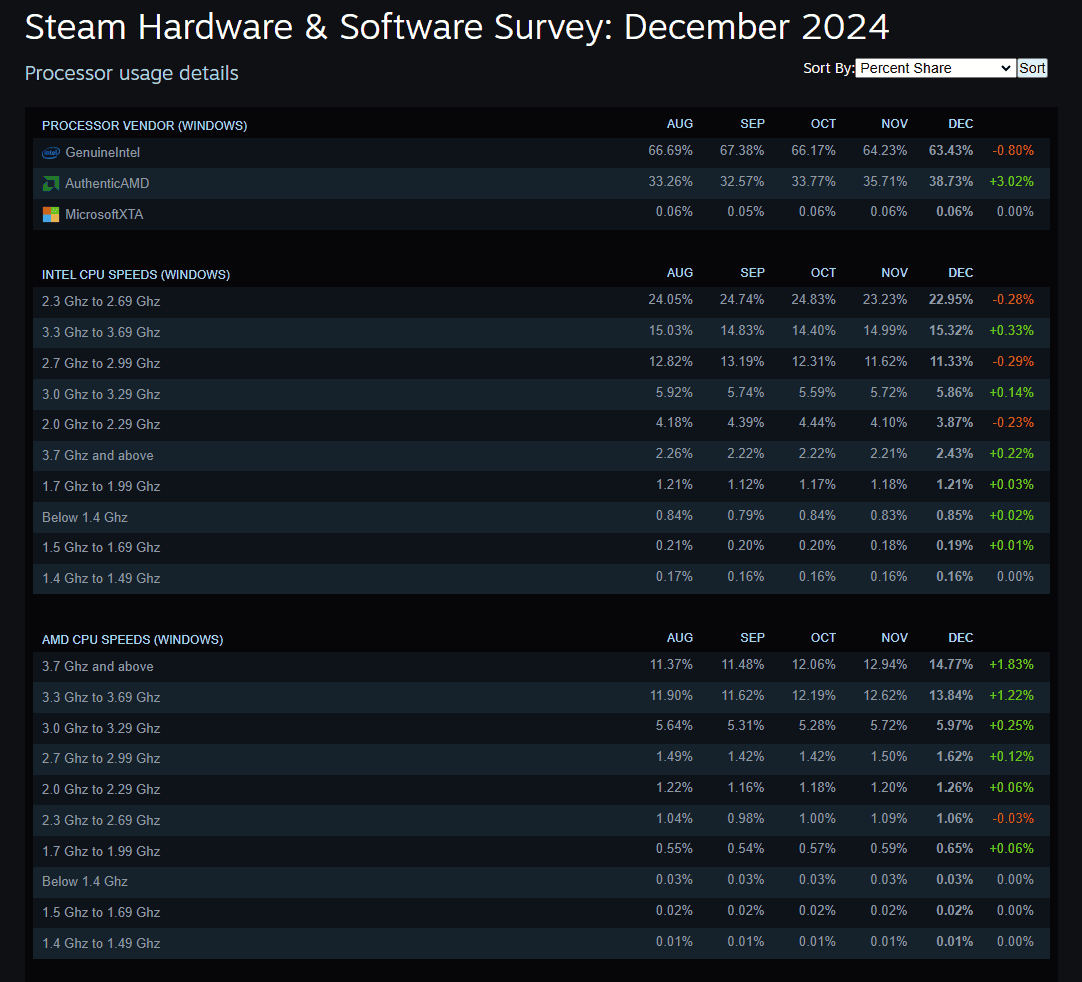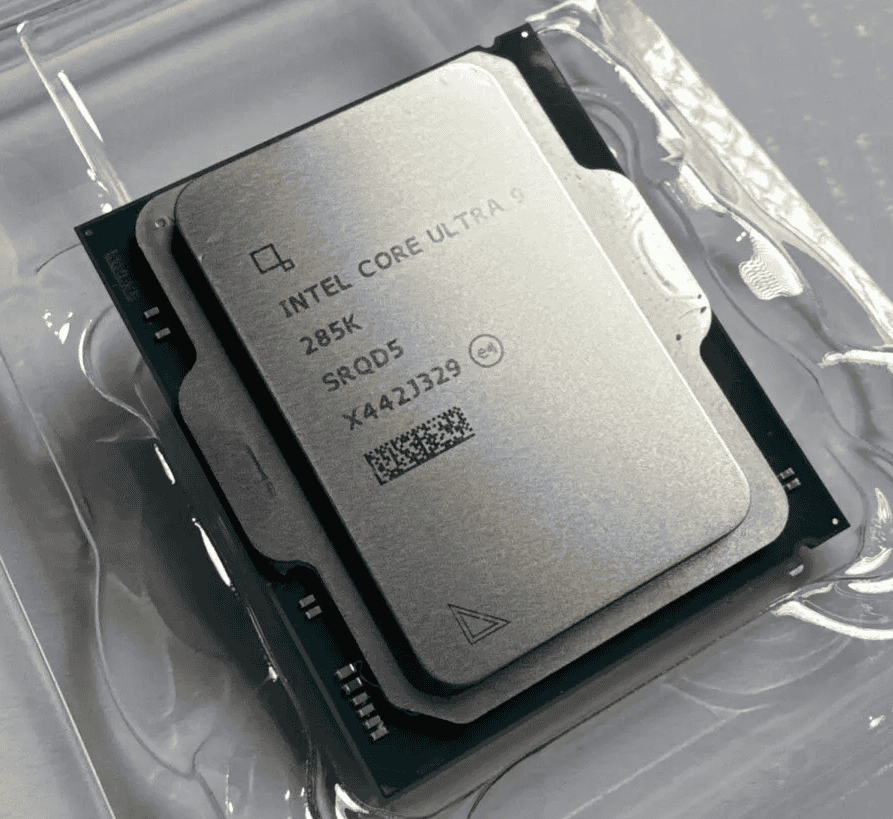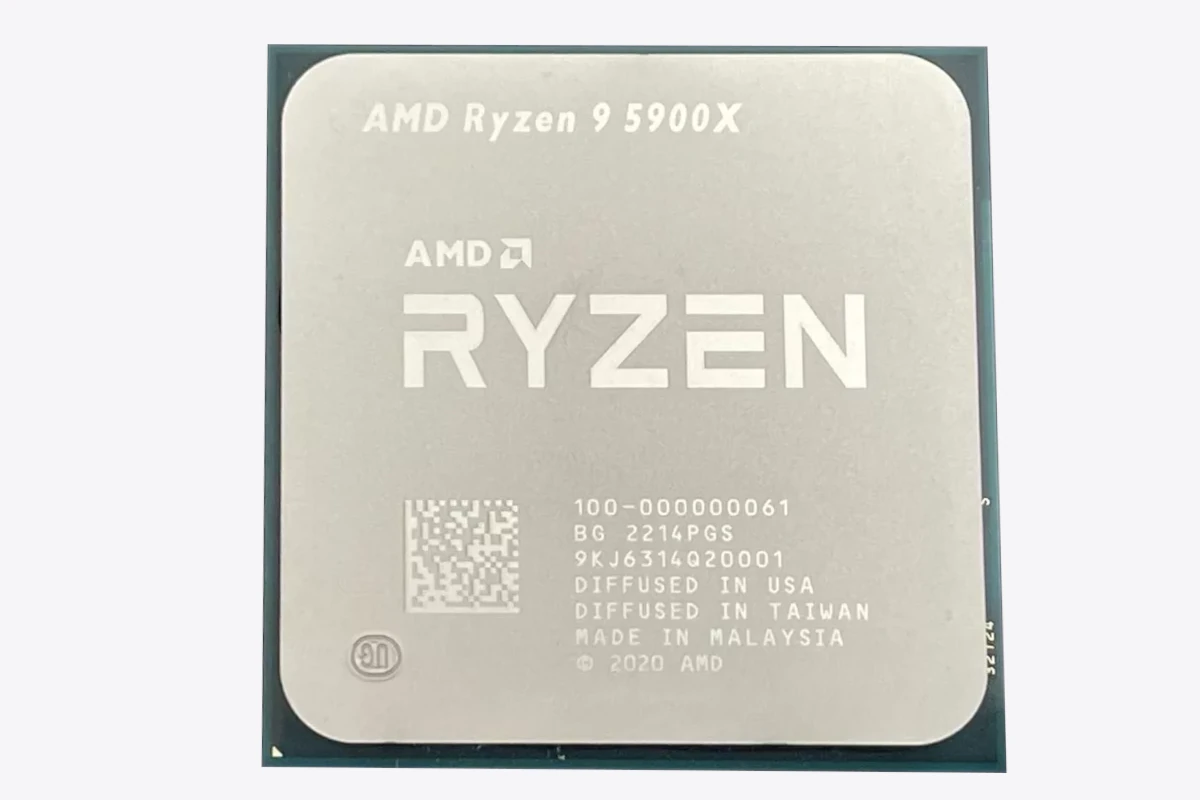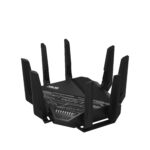The latest Steam Hardware Survey indicates a significant shift in the CPU market for gamers, with AMD increasing its share to 38.73% in December 2024. This change reflects a growing preference for AMD’s Ryzen CPUs, attributed to the strong performance of the Ryzen 7000 series, the stability of the AM5 platform, and a positive reception of the Zen 5 architecture. No chips have garnered more favor than AMD’s 3D cache lineup including the most recent launch – the AMD 9800X3D.
The change can also be attributed in part to issues Intel has had with their 13th Gen and 14th Gen chips coupled with mediocre adoption of the new 15th generation (Arrow Lake) by gamers.
The competitive landscape between AMD and Intel is leading to more consumer options, driving innovation, and potentially lowering prices in the industry.

AMD’s Rising Popularity Among PC Gamers
– AMD has increased its CPU market share to nearly 40% of the Steam user base as of December 2024.
– This growth is attributed to innovative product launches and strategic positioning against Intel.
– The Ryzen series has received positive reception, contributing to AMD’s success.
– AMD’s future growth will rely on ongoing innovation, competitive pricing, and customer-focused improvements.
AMD’s Market Share Growth
The Steam Hardware Survey, a monthly data collection of Steam users’ computer hardware, shows AMD making significant gains against Intel in the CPU market. The December 2024 survey reveals AMD’s CPU market share reached 38.73%. This is a substantial increase, showing a gain of almost 5% in the last couple of months. While Intel still holds the larger portion, AMD’s growth is a clear trend.
What the Numbers Mean
This data comes from a large sample of Steam users. Steam is a leading platform for PC games. So, its hardware survey gives us a good look at what CPUs gamers use. A rise in AMD’s share means more gamers are choosing AMD processors for their gaming PCs.
Why AMD is Gaining Ground
Several factors likely play into AMD’s success:
- Strong Products: AMD’s Ryzen 7000 series CPUs, especially those with 3D V-Cache, are popular for gaming. These chips offer great performance in games.
- Platform Stability: The AM5 platform, which is AMD’s current CPU socket, has good support and a clear upgrade path. This makes it attractive to people building new PCs.
- Positive Reviews: AMD’s Zen 5 architecture has earned positive reviews from tech experts and users. This creates positive buzz and encourages people to choose AMD.
How AMD Stacks Up Against Intel

Although AMD is gaining ground, Intel still leads the CPU market among Steam users. Here’s a quick comparison:
| Feature | AMD | Intel |
|---|---|---|
| Current Top Gaming CPUs | Ryzen 7000 Series (especially with 3D V-Cache) | 13th and 14th Gen Intel Core processors |
| Socket/Platform | AM5 | LGA 1700 |
| Recent Trend (Steam Survey) | Gaining market share | Losing market share |
What This Means for Gamers
Increased competition between AMD and Intel is good for gamers. It pushes both companies to innovate and offer better products at competitive prices. This can lead to better performance and more affordable options for PC gaming.
Considering a New CPU?
If you plan to build or upgrade a gaming PC, both AMD and Intel offer strong choices. Consider your budget, the games you play, and the features you need. Research benchmarks and reviews to make an informed decision.
Beyond Gaming: CPU Use in Other Applications
While the Steam Hardware Survey focuses on gamers, CPUs are used for much more than just playing games. They are essential for all computer tasks, including work, content creation, and general use. The performance of a CPU impacts how fast your computer runs programs, edits videos, and handles multiple tasks at once. For tasks like video editing or 3D rendering, CPUs with more cores and threads are generally preferred. For everyday tasks like web browsing and office work, a less powerful CPU is often sufficient. The choice of CPU depends heavily on the specific needs of the user.
Short Summary:
- AMD’s market share among Steam users surged to 38.73% in December 2024, marking significant growth from previous months and a notable decline in Intel’s dominance.
- The introduction of cutting-edge processors like the Ryzen 7 9800X3D has propelled AMD to new heights, while Intel grapples with disappointing performance from its latest offerings.
- The company’s success in both server and mobile markets has strengthened its position, indicating a robust future for AMD’s product line.
The latest data from the Steam Hardware Survey reveals AMD’s meteoric rise in the CPU market, reaching a 38.73% share among Windows users in December 2024. This growth marked an increase of 3.02% from the previous month and put AMD tantalizingly close to the 40% threshold. Meanwhile, Intel’s market share dwindled to 63.43%, a stark contrast to AMD’s rapid ascent. This significant shift comes after years of stagnation for AMD, as it previously struggled to break the 30% barrier for Steam users.
AMD’s success in the market can largely be attributed to the favorable reception of its Ryzen processors. Notably, the Ryzen 7 9800X3D has been hailed as “The New Gaming CPU King,” solidifying AMD’s reputation in the gaming community. Early reports indicated that this chip quickly sold out across various retail platforms, demonstrating high consumer demand. AMD’s Ryzen 7 7800X3D, which launched earlier in 2024, has also performed exceptionally, with nearly 80,000 units sold through major retailers like Mindfactory in Germany.
“AMD is not just competing, but thriving in a market that was once dominated by Intel,” commented a tech analyst, “The recent product launches have resonated well with gamers and professionals alike.”
On the contrary, Intel finds itself facing challenges. Their recent processors, particularly the Core Ultra 200S “Arrow Lake” series, have underperformed, selling only 380 units since their launch in October. In contrast, AMD’s Ryzen range has made substantial gains in market share, particularly in the higher-performance segments. Among Linux users, AMD’s share also increased, solidifying its position with a share jumping to 73.6% in December, reflecting a broad acceptance of its products across platforms.
GPU Market Landscape
AMD’s success extends beyond CPUs; it has also made a notable impact in the graphics card segment. According to the Steam survey, NVIDIA remains the leader in the GPU market, particularly with its GeForce RTX 3060 and RTX 4060 series. The RTX 4060, for instance, has surged in popularity, becoming a preferred choice among mainstream gamers. Meanwhile, AMD’s GPU lineup is led by the Radeon RX 6600, which has emerged as its most successful desktop card.
“NVIDIA’s ability to innovate has kept it in the lead, but AMD is closing the gap with competitive pricing and performance,” said an industry expert, reflecting on the evolving dynamics of the GPU market.
As the survey highlighted, the overall GPU landscape is still overwhelmingly dominated by NVIDIA, with the RTX 3060 at the top of the list of most popular cards among Steam users. However, AMD’s efforts in the graphics segment are not to be overlooked, and its Radeon GPUs are starting to gain traction in specific segments.
Market Trends and Consumer Preferences
The device landscape painted in the Steam survey tableau assists in discerning various trends that may inform future purchases and shifts in strategy. Among RAM configurations, 16GB remains the standard for most users, although a gradual increase in the adoption of 32GB systems shows the changing needs of gamers and professionals who require more memory for demanding applications.
- 56.1% of participants continue to use 1080p resolution, though the market for 1440p gaming is expanding.
- The operating system landscape is notably shifting; Windows 11 has now captured nearly 55% of the share, as it gathers momentum at the expense of Windows 10.
The results of this survey reveal the preferences of modern gamers and highlight AMD’s importance in fulfilling these needs as it continues to evolve its product offerings. Despite its recent success, AMD’s future depends also on maintaining competitive pricing and leveraging software partnerships to enhance the gaming experience further.
AMD’s Broader Market Impact
Emerging from its streak of growth in the consumer market, AMD has also seen a rise in its performance within the server and mobile sectors. Notably, its EPYC server CPUs have captured significant market share, reflecting the increasing demand for cloud computing solutions and enterprise-level systems. The data centers alone have contributed over $6.4 billion to AMD’s revenue streams in 2024, with projections for further growth as AMD’s technological competency improves.
“The way AMD has integrated its Ryzen technology into data centers is impressive and shows their capability to compete not just in desktop but also in enterprise segments,” remarked a senior analyst at a leading tech research firm.
As the company approaches the launch of its next-generation Ryzen 9000 series based on the Zen 5 architecture, expectations are high for substantial market impact. With current CPUs offering strong competitive value against Intel’s offerings, analysts foresee sustained momentum.
Future Outlook
Looking ahead, AMD’s strategic focus on both performance optimization and market expansion signals a promising trajectory. The advent of the Ryzen AI 300 “Strix” laptops paves the way for further competition in the mobile computing space against rivals like Intel and Qualcomm. Similarly, AMD’s redesigned server models are expected to cater well to cloud operations and high-performance computing needs, particularly as companies continue shifting their operations to the cloud.
Intel’s struggles in maintaining its market dominance prompt speculation about whether they can rebound against such strong opposition. The reduction in their market share and the challenges tied to their new product lines indicate an uphill battle in their quest for market leadership.
“AMD’s aggressive pricing and innovative product strategies are reshaping the dynamics of the CPU market, making it an exciting time for industry followers,” concluded a reputable tech commentator.







